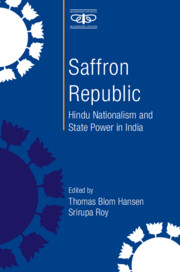7 - Social Segregation and Everyday Hindutva in Middle India
Published online by Cambridge University Press: 31 May 2022
Summary
Following the 2014 general election that brought Modi to power, enormous attention was paid by many commentators and analysts to the appeal of Modi to a young and restless electorate, particularly young men aspiring to jobs and recognition in a rapidly growing economy. It is true that the spectacular election campaign in 2014 moved the crucial few per cent of the vote in key states in north and central India that allowed the Bharatiya Janata Party (BJP) its unprecedented win of seats in Lok Sabha (Chibber 2014). Many of these gains, especially in Uttar Pradesh, were consolidated in 2019. It is also true that the BJP has been able to establish itself in new arenas, such as throughout the Northeast (Longkumer 2019).
However, the bulk of the electoral support for the BJP in both these election cycles came from regions and social milieus where the party and other organizations affiliated with the Rashtriya Swayamsevak Sangh (RSS) had already established a firm standing since the early 1990s. When we consider the characteristics of ‘new’ Hindutva, the main analytical challenge is to understand how the key tenets of Hindutva seem to have been consolidated into a form of everyday common sense and widespread sentiment, and how this has allowed the BJP to reproduce and further extend its support throughout the towns, cities, and villages of northern, central, and western India for more than three decades. Here, I will explore how the ideological frames of Hindutva have been coarticulated with other social processes and identity formations that mark everyday social life in much of northern and western India.
I shall explore such processes of coarticulation by looking at the long history of Hindu nationalist mobilization and consolidation in Aurangabad, Maharashtra, a city known in the prose of the Indian police as ‘riot prone’ and a hotbed of Hindu communal activism since the 1980s when Shiv Sena made it its first major stronghold outside of Mumbai.
While Aurangabad may be unique with regard to its history of communal violence, it exhibits many of the same features as other growing cities in the Deccan region and western India. Aurangabad has trebled its population (estimated to be 2.1 million in 2018) in the past thirty years, just like Hyderabad (> 10 million), Bhopal (2.7 million), Nagpur (2.9 million), and Indore (3.1 million).
- Type
- Chapter
- Information
- Saffron RepublicHindu Nationalism and State Power in India, pp. 158 - 180Publisher: Cambridge University PressPrint publication year: 2022

